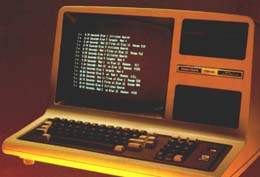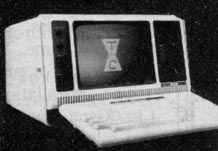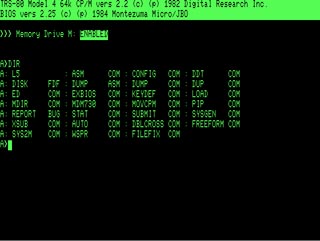
Contents
Overview
The Plain Model 4
The Model 4D
The Portable 4P
Emulators
Operating Systems
TRSDOS
LSDOS
DOSPLUS
Montezuma CP/M
CP/M Plus
Hardware
Model 4

Model 4, 4P and 4D OverviewThe greatest computer, ever! That's my opinion, and you can flame me for that remark from now until the end of eternity, I don't care. It won't change my opinion. I'll just look at you like you've sprouted two heads. I use my Model 4 (or the Model 4 emulator) just about daily for various projects. The machine is just a dream to operate. Programming for the Model 4 was very painless. All the operating system services were accessed via one central RST 28H call, with the service desired in the A register of the CPU. This allowed the internals of the operating system to change without breaking any application programs. The idea was that all access to the hardware should go through the operating system, in order to allow the same program to run on any machine that Logical Systems could get a version of their operating system written for. As far as I know, the Model 2 was the only other machine supported. I never found that out until after getting "The Source" to TRSDOS 6.2 which LSI published. |
The Model 4
The standard 4 was a 64k (or 128k) machine that had single-sided double density disks. Tandy got smart for this machine, and had Logical Systems write TRSDOS 6 for them. This was the same company that wrote the "Hard Disk Operating System", LDOS 5.x, for both the Model 1 and 3, so they knew what they were doing. The Model 4 looked a lot like the Model 3, and even contained the Model 3 ROMs. If you turned the machine on without a diskette in it, it would boot up just like a Model 3. The magic happened when you booted up a Model 4 DOS. The machine swapped out the boring old ROM for 64K of RAM, allowing it to run CP/M as well as TRSDOS 6.x or Model 4 DOSPLUS. The screen and keyboard were still memory mapped, but it was a "hidden" map. An output port set whether the system's RAM or the screen and keyboard were mapped into upper memory, although it wasn't documented how to do that yourself. The idea behind the DOS was to let the operating system handle all that for you, so the same program would run on any LS-DOS 6.x based machine. There were a number of variations of the Model 4. The main differences being whether the machine was easily upgradable to 128k or not. The older motherboards required a new PAL chip in addition to some other changes. The newer "Gate Array" boards simply required changing a jumper. In addition, there were two styles of keyboard layout. The older one had the arrow keys to the left and right of the main typewriter area. The other had the arrow keys in an inverted T cluster between the keyboard and the number pad. You can compare this picture to the Model 4D below to get an idea. |
The Model 4D
The Model 4D was basically the same machine, but it came with double sided disk drives. That was one of the first things many people did to their Model 4s, so it was a "natural" idea for a new machine. The drives were actually half-height drives with a full-height bezel, as you can see in the picture. That came from a page with a crinkle in it, by the way... the real machine didn't have those obvious imperfections in the screen. :) After a little research, it seems that the "D" actually was supposed to stand for "Deskmate", since that software was bundled with this revision of the Model 4. I forget where I learned that piece of information from, probably by reading it in the comp.sys.tandy newsgroup. Deskmate was a fairly decent integrated package that included word processor, spreadsheet, filer, calendar, telecommunications and electronic mail modules. None of these were very powerful, especially by today's standards, but for the person just starting out, they were pretty handy. |
The Model 4P
The Model 4P was supposedly "portable", but it was still a fairly substantial box. Mine weighs in at around 25 pounds. The standard configuration was 2 half height single sided drives, and 64k. This machine had the best keyboard out of all the TRS-80s. There was no Model 3 ROM included, but the 4K boot ROM it had could read a Model 3 ROM image file off diskette for the people who needed to run Model 3 software. In addition to the built in serial port, the 4P could be equipped with an internal modem... as long as you didn't want to go any faster than 300 baud. The Model 4P was the only TRS-80 computer that would attempt to boot from a hard disk, if one was attached. Several people (Adam Rubin mainly) worked on patches to allow TRSDOS 6.x (and LS-DOS 6.3) to boot a Model 4P from hard disk. I used Adam's patch with LS-DOS 6.3.0, and it worked rather well. Later I purchased a Model 4P ROM upgrade from M.A.D. Software (see the main page for contact information). With that, I purchased their own patches to allow the 4P to boot from hard disk, which works with the TRSHD6/DCT hard disk driver and also the RSHARD driver from Misosys. The Model 4P would also (if the Network 4 card was attached) boot from a Network 4 host machine. I'm not too sure how this was supposed to have worked, but the code for it is in the ROM. Top |
Model 4 Operating SystemsLike the other TRS-80s, the Model 4 had several disk operating systems available for it. In addition, it could run all the Model 3 operating systems, since the machine contained the Model 3 ROMs (or could load an image of them, in the case of the Model 4P). There were several TRSDOS-like operating systems available, as well as the very popular CP/M. I've put together a page of information about the TRSDOS/LS-DOS commands. This covers the built in library commands, as well as the standard utilities that come with TRSDOS 6.x and LS-DOS 6.3. Some of this information is also good for DOSPLUS, though there are quite a few differences. |
TRSDOS 6
In a fit of sanity, Tandy decided not to write TRSDOS 6. They had Logical Systems, the people who had written LDOS for the Models 1 and 3, do it for them. This was a good move on their part, because TRSDOS 6 wound up being a pretty good DOS. It had all the nice device indepenence of LDOS, and added a great programming feature. All the operating system calls were through a Z-80 RST instruction with the call number passed in the A register. This allowed the internal addresses of the various routines to move without affecting any user programs. This was very similar to the CP/M method of calling BIOS and BDOS services. If you had $300.00 back then, you could get "The Source" from Logical Systems, which was a three volume set of books containing the complete commented source code listings to TRSDOS 6 and its utilities. I got lucky and found a copy a few years ago. I wish I could find the Super Utility source code, too. (That's a hint just in case Kim Watt ever stops by and reads this page... hehehehe) |
LSDOS 6.3.x
Logical Systems also sold their own updated version, called LS-DOS. This is the Model 4 DOS to have. It added support for dates past 1987, fixed a few bugs in TRSDOS 6.2, and generally works better. When I checked in December 1995, the LS-DOS upgrade was still available from Radio Shack through their "Express Order" catalog for about $40US. Of course, instead of paying for it, you can always download it from Tim Mann's site, which is linked to a few paragraphs down. You'll need a way to make TRS-80 disks out of .DSK files, but he's got a FAQ on doing that, too. :) Once I had gotten my copies of "The Source", I realized that I really wanted to have it in machine readable form. I managed to type in (by hand) most of the first couple of modules before gettins smart. I realized that I had a perfectly good disassembler, and it could to all the hard work for me, and give me the source to LS-DOS 6.3.1 at the same time! So that's what I did. I used Roy Soltoff's wonderful DSMBLR package to disassemble the complete operating system, and went back through it using "The Source" to add all the comments, figuring out the new stuff as I went along. The final result was the full source code to the operating system and all its utilities. I wound up having to write a little program in Misosys PRO-MC to handle the library modules, (SYS6/SYS, SYS7/SYS and SYS8/SYS) because the assembler couldn't create ISAM modules directly, but when I was finished, I had byte-for-byte images of the files on the original distribution disks from Misosys. Tim Mann got permission from Roy to put all the Misosys software online, and eventually I sent him the source I had, along with all the JCL files I use to re-assemble it. If you're interested, those files are all available on Tim's site at http://www.research.digital.com/SRC/personal/Tim_Mann/trs80.html along with all the other Misosys software that Roy's been able to find and send to him. If you get the LS-DOS source, you'll want to get the PRO-MRAS assembler as well, since that is the one I used to re-assemble the thing, and all the JCL files are set up to use MRAS. |
DOSPLUS
DOSPLUS was another Model 4 DOS that was pretty good. It added a few operating system calls that weren't in TRSDOS/LS-DOS, so programs that were written specifically for DOSPLUS (like their handy MEDIC point-and-shoot program runner) wouldn't run on TRSDOS/LS-DOS. Micro Systems Software had drivers that supported the Radio Shack hard drives, but I've never seen them in actual use. |
Montezuma Micro CP/M
Since the Model 4 ran with 64K of RAM, it was able to run CP/M. Montezuma Micro had what many consider the best implementation for the Model 4. To tell the truth, I'm not even sure what other CP/Ms there were. I think Tandy had one. Montezuma Micro CP/M 2.2 supported quite a number of hard disks, if you purchased the driver, and on the Model 4P it would boot directly from the hard drive, if the controller was compatible with the TRS-80 WD1000/WD1010 controller. From Peter in Atlanta (that's all the name I have) <bavarius@bellsouth.net>
|
CP/M PlusTandy sold CPM Plus for the Model 4. That's all I know about it. Luckily for us, I'm not the last word in TRS-80 information. From: "John R. Grant" <jgrant@traveller.com> Thanks, John! |
Other hardware and stuff
The picture above is of a Radio Shack primary hard disk unit that could be used with the TRS-80 Model 4, III and (with an adapter) the Model 1. I've got three of these right now, though only one has the original 15 meg hard disk that came in it. The other two are using Miniscribe 6085 70 meg drives, and are partitioned using Misosys' RSHARD package to utilize the whole thing at one swell foop. 
Later, Tandy came out with a much smaller 10 megabyte hard disk unit that was not much bigger than an external floppy drive. The Model 4 controller for this was the same size and could handle a couple of these. I used to have one of these boxes a few years ago, but it got lost in a move. <grumble> Hires GraphicsFun hardware that was available included a high resolution graphics board, which gave 640 by 240 pixel monochrome graphics. Text and graphics could be overlaid at the same time, and several programming languages supported it, including the Microsoft BASIC compiler. There were two different hi-res boards, one by Tandy and another by somebody else... Clue me in, someone. (Thanks to Bill Chao (bill@dss.com), we now remember it as the Grafyx Solution, put out by Micro-Labs. Computer News 80 may still have a few of these for sale.) From Bob Bottomley < Robert.A.Bottomley.Jr@cdc.com> comes:
Memory expansionAlpha Tech(?) sold memory expansion kits that allows quite a bit of extra RAM to be installed. I think the largest I recall hearing about was a 256k board that brought the total up to 384k! I always wanted one of those (and still do!). XLR8R boardThere was also a great little piece of hardware called the XLR8er. This was based on a Hitachi HD64180 processor that replaced the Z-80. I'm not sure what the top speed was, but it made for a darn fast machine.
From Steve Mello (mello.med@shands.ufl.edu comes this: Your web pages mentioned XLR8er. I just thought you might want to know a little more about it. XLR8er provided speed increases up to 500% over a stock Model 4. It has 256 KBytes of additional high speed RAM memory (150ns) which can be configured as a RAM disk, user program memory or both bringing the total RAM available to 384 KBytes (if you have a 128 K Model 4), and a HD-64180 processor (8 MHz Z80 compatible). The XLR8er was compatible with all known hardware and software at the time of release and installation was a snap, just plug it in. They originaly sold for $299.95 I believe. The company that developed it was called H.I. Tech, Inc. somewhere in Texas. Thanks, Steve. From Bob Bottomley < Robert.A.Bottomley.Jr@cdc.com> comes:
Thanks a million, Bob. That really gives us quite a bit of info on the XLR8R. Top |
The TRS-80 Home Page created and maintained by Pete Cervasio
cervasio@airmail.net
Copyright © 1998 Pete Cervasio